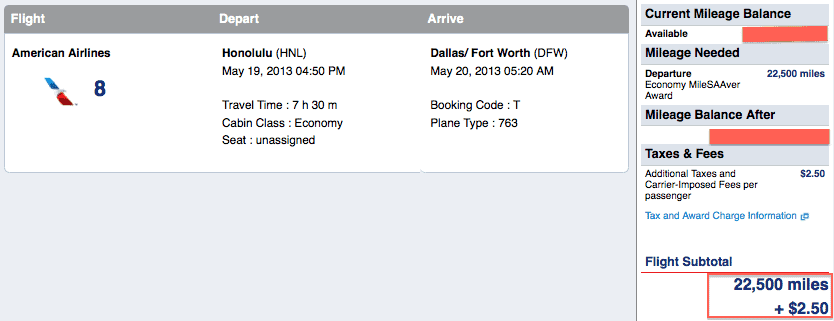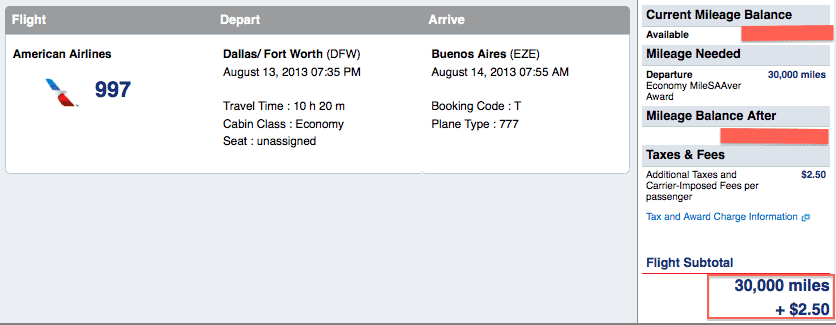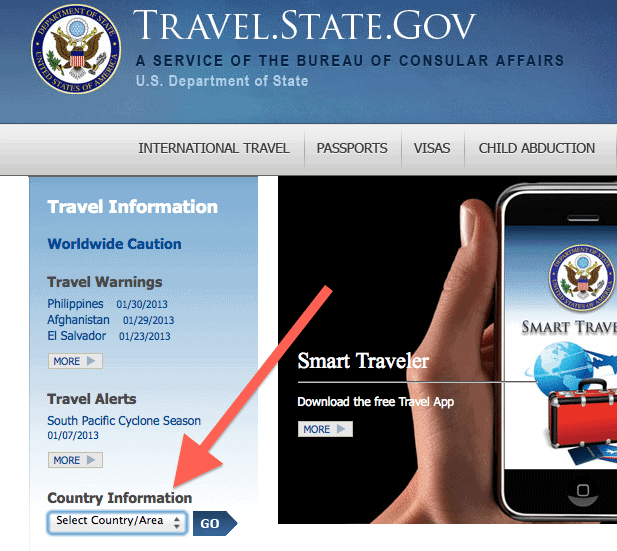MileValue is part of an affiliate sales network and receives compensation for sending traffic to partner sites, such as CreditCards.com. This compensation may impact how and where links appear on this site. This site does not include all financial companies or all available financial offers. Terms apply to American Express benefits and offers. Enrollment may be required for select American Express benefits and offers. Visit americanexpress.com to learn more.
Note: Some of the offers mentioned below may have changed or are no longer be available. You can view current offers here.
Or: The Whole is Less than Either of its Parts
If you take a look at the American Airlines award chart, you’ll see that Honolulu to Dallas costs 22,500 miles each way in economy. And Dallas to Buenos Aires costs 30,000 miles each way in economy.
 Luckily both Hawaii and South America Zone 2 (most of South America including Argentina) have some dates when you can fly in economy at a discount.
Luckily both Hawaii and South America Zone 2 (most of South America including Argentina) have some dates when you can fly in economy at a discount.
Hawaii’s off peak pricing of 17,500 miles each way runs from January 12 to March 8 and August 22 to December 15. South America Zone 2’s off peak pricing of 20,000 miles each way runs from March 1 to May 31 and August 16 and November 30.
Those are the listed off peak dates, but I’ve already cracked how to enjoy off peak pricing all year round by choosing an appropriate date for your free oneway.
So I wanted to see whether I could get a date listed as a peak date to Hawaii plus a date listed as a peak date to South America Zone 2 to price below what either one should cost. And it’s actually quite easy. Here’s my goal.
- What a peak flight Honolulu to Dallas costs (22.5k) + what a peak flight Dallas to Buenos Aires costs (30k) = 52.5k
- Peak flight Dallas to Buenos Aires = 30k
- Peak flight Honolulu to Dallas = 22.5k
- Goal: Peak flight Honolulu to Dallas + peak flight Dallas to Buenos Aires = 20k total
What I learned when I figured out how to get off peak pricing of 20k miles to Europe all year round is that American Airlines determines whether your award is off peak or peak based only on the date of the first flight of the itinerary.
I could fly a peak July flight from Los Angeles to Berlin for 20k miles as long as I added a flight beforehand from somewhere, say San Francisco, to Los Angeles during Europe’s off peak season.
The same principle applies to this award. The first leg–Honolulu to Dallas–must occur during the off peak window to South America Zone 2 for the entire award including the flight to Buenos Aires to price at the South America Zone 2 off peak price of 20k miles one way.
What I wasn’t sure about was whether there was an additional date requirement for the flight from Honolulu to Dallas. After all, Honolulu to Dallas on its own can cost 17,500 miles or 22,500 miles depending on whether it is flown during a peak or off peak period.
I was wondering whether I needed to fly from Hawaii to Dallas during the Hawaii off peak season, and it turns out I don’t. The only requirement for Honolulu-Dallas//Dallas-Buenos Aires to price at 20,000 miles is that Honolulu to Dallas be flown during South America Zone 2’s off peak season.
In case you’re confused about why this screen shot is showing such an incredible deal, consider it compared to the next two screen shots. The above picture is 20,000 miles. The same exact flights, booked separately, each cost more than 20,000 miles and total 52,500 miles.
I don’t think this is theoretical either. This trick should have lots of practical applications.
Best Use
The best use is if you live at a city in the continental US and can have parts of two vacations on one award. If you lived in Dallas, you have half your trip to Argentina and half your trip to Hawaii figured out for 20,000 miles total. The other halves can handled by cash tickets or oneway awards with United, British Airways, or American miles.
You don’t have to live in Dallas to take advantage. You can also live in Miami, New York, or Los Angeles. What’s special about these cities? They have direct flights on American or LAN (a oneworld partner) to South America Zone 2. Direct flights are important to satisfy American’s stopover rule. See The Five Cardinal Rules of American Airlines Awards.
If you don’t live in any of those cities, you are hardly out of luck. If your home airport has a direct flight operated by American Airlines to one of those cities, you can still enjoy substantial savings by using this one easy trick.
Or you can use Buenos Aires as a hidden city.
If you live in Dallas, and you just want a return trip from Hawaii, 20k miles represents a discount over the peak price of 22,500 miles. You could book the itinerary in this post, adding Buenos Aires as a hidden city you never plan to fly to. Get off in Dallas and save your 2,500 miles.
This isn’t a great use of this trick. One of the many reasons is that you could find a better hidden city. If you choose a Central American city, the award would only cost 17,500 miles meaning a Central American hidden city would save 5,000 miles.
Recap
Honolulu to Dallas is 22,500 American Airlines miles.
Dallas to Buenos Aires is 30,000 American Airlines miles.
Honolulu to Dallas to Buenos Aires is 20,000 American Airlines miles.
This trick is valuable for those who live at a oneworld gateway to South America, and it’s valuable for anyone who lives within one direct flight of such a gateway.
Bonus
If you travel to EZE airport on an American passport, you have to prepay a $160 fee and print your receipt before flying. I was once chided in the comments for not mentioning that. I rarely mention things like visas and entrance fees because I don’t keep up with those things. Before taking any trip, do what I do and look up your destination’s info on travel.state.gov.
That’s how I learned Uganda, Tanzania, and Kenya would ding me for $175 total. (Thanks for not charging me, Rwanda.) I also know that Chile and Brazil charge Americans $160.






Dear Scott you are a genius but in the example of american air getting two trips for the price of less than one how were you able to separate the itenenaries> Perhaps I missed something and will look at it again.
Look at the dates of the two flights: May 19 and August 13. I use the rule that you can get a stopover at the international gateway city–in this case, Dallas.
Dear Scott you are a genius but in the example of american air getting two trips for the price of less than one how were you able to separate the itenenaries> Perhaps I missed something and will look at it again.
Look at the dates of the two flights: May 19 and August 13. I use the rule that you can get a stopover at the international gateway city–in this case, Dallas.
Another outstanding post. Your knowledge is impressive. Since American doesn’t display LAN, I need to call to book the award ticket. Is there a way to avoid American’s phone fee like there is with United? I take it this prices low with business fares too? Thanks!
This will price better in business to N. South America (30k) than S. South America (50k). You have to call for LAN, and you can’t avoid the phone fee. If you figure out a way, let me know.
Another outstanding post. Your knowledge is impressive. Since American doesn’t display LAN, I need to call to book the award ticket. Is there a way to avoid American’s phone fee like there is with United? I take it this prices low with business fares too? Thanks!
This will price better in business to N. South America (30k) than S. South America (50k). You have to call for LAN, and you can’t avoid the phone fee. If you figure out a way, let me know.
Many good ideas in this post, but the hidden city trick is against airline policy and if they find out about it, they won’t be calling to congratulate the customer on his or her ingenuity. I also question the ethics of booking a hidden city flight to Buenos Aires to save 2,500 miles. For a personal benefit equal to about $35, someone who does that is depriving another passenger of a chance to book that seat and enjoy a reward. Reward seats are not unlimited. Use tricks to save miles on flights you will actually fly, not to deprive someone else of of his or her chance to book a trip.
Many good ideas in this post, but the hidden city trick is against airline policy and if they find out about it, they won’t be calling to congratulate the customer on his or her ingenuity. I also question the ethics of booking a hidden city flight to Buenos Aires to save 2,500 miles. For a personal benefit equal to about $35, someone who does that is depriving another passenger of a chance to book that seat and enjoy a reward. Reward seats are not unlimited. Use tricks to save miles on flights you will actually fly, not to deprive someone else of of his or her chance to book a trip.
It is great to see Mile Value re-emphasing its vast knowledge of redemption tools. Keep it up!
It is great to see Mile Value re-emphasing its vast knowledge of redemption tools. Keep it up!
This is almost exactly what I’m trying to pull off right now, except I’m trying HNL-JFK (now through May) and JFK-EZE (December) for 4 people….. not an easy job… Thanks for the great tips and happy travels!
Good luck. And take a look at flying JFK-SCL-EZE.
This is almost exactly what I’m trying to pull off right now, except I’m trying HNL-JFK (now through May) and JFK-EZE (December) for 4 people….. not an easy job… Thanks for the great tips and happy travels!
Good luck. And take a look at flying JFK-SCL-EZE.
Great job, here. I really like how you’re finding all the tricks of award charts, especially the AA one.
Great job, here. I really like how you’re finding all the tricks of award charts, especially the AA one.
This is good. Living in New York, American Airlines’ stopovers routings can be done all the time. I used it to come back from Grand Cayman the Sunday after Thanksgiving in November and to go to Rio de Janeiro the weekend before Christmas! Details here:
Thanksgiving in Grand Cayman, New Year’s in Rio and Fourth of July in Greece
In terms of Visa requirements, you do need to submit your passport, two passport photos and a fully booked itinerary and fill out a form online that you then print out and bring in. Also, you will need a money order for the payment so make sure to do this ahead of time! The proceedings differ for each region, but is not too big a deal. It can take up to two weeks so make sure to have a two week period where you don’t need your passport.
This is good. Living in New York, American Airlines’ stopovers routings can be done all the time. I used it to come back from Grand Cayman the Sunday after Thanksgiving in November and to go to Rio de Janeiro the weekend before Christmas! Details here:
Thanksgiving in Grand Cayman, New Year’s in Rio and Fourth of July in Greece
In terms of Visa requirements, you do need to submit your passport, two passport photos and a fully booked itinerary and fill out a form online that you then print out and bring in. Also, you will need a money order for the payment so make sure to do this ahead of time! The proceedings differ for each region, but is not too big a deal. It can take up to two weeks so make sure to have a two week period where you don’t need your passport.
I agree with DaveS, award availability is already difficult to find.
I agree with DaveS, award availability is already difficult to find.
Great post.
How do I try to find ticketing for 20k miles from OGG to LAX or SFO then on the South America? I can see it through DFW but not LAX/SFO.
Thank you for your help.
From LAX, you have a few direct LAN options to South America. From SFO, you have the direct LAN flight to Lima. You need to get on one of those direct LAN flights to make this work. You can search them on ba.com and book over the phone. AA.com doesn’t display them.
Alternatively, you can fly directly from LAX to Europe on AA or airberlin, which are both searchable on aa.com. This is a 20k itinerary waiting to happen.
Great post.
How do I try to find ticketing for 20k miles from OGG to LAX or SFO then on the South America? I can see it through DFW but not LAX/SFO.
Thank you for your help.
From LAX, you have a few direct LAN options to South America. From SFO, you have the direct LAN flight to Lima. You need to get on one of those direct LAN flights to make this work. You can search them on ba.com and book over the phone. AA.com doesn’t display them.
Alternatively, you can fly directly from LAX to Europe on AA or airberlin, which are both searchable on aa.com. This is a 20k itinerary waiting to happen.
Hmm.. I tried inputting these dates:
OGG-LAX JUL14
LAX-MAD NOV18
And I’m getting priced at 30K. But if I choose a day in May (ie. MAY15) for OGG-LAX, then the 20K pricing shows up.
Yes, choose any date between October 15 and May 15 for OGG-LAX, and it will be 20k. See https://milevalu.wpengine.com/20k-miles-to-all-of-europe-all-summer/ for the reason.
That’s a handy technique, but living in Philadelphia really sucks for participating in these One World deals. Of course, that may change soon…
Have you successfully booked this? I tried to book Maui-SFO-Lima using the SFO-Lima nonstop on LAN and stopping in SFO for a while, and the AA agent said it wouldn’t go through. I tried it with at least 2 different agents and got the same result. I concluded that maybe it was specifically blocked since the Hawaii routing requires more miles than the South America routing.
I didn’t click purchase, but I had the option to on aa.com. I think the problem might have been that LAN didn’t have a published fare OGG-LIM. Have you checked that?
Great post, thinking of doing the same since dallas is my home city, and going to rio or sap paulo for world cup next yr when tickets become available ..
Totally agree with DaveS. Micky Mouse way to save 2500 miles.
Great suggestions, Scott. Your posts are quickly becoming mandatory reading for anyone wanting expertise in earning and using AAdvantage miles. Would love in a future post for you to apply your expertise to ways to maximize the OneWorld Explorer ticket. I’ve seen decent posts about paid AA RTW tickets, and Flyertalk has some excellent guidelines on the Explorer ticket, but no one has really done a comprehensive discussion of how best to maximize the value. For example, I’m planning a honeymoon using the Explorer ticket flying out of ATL in December – lots of flexibility on destinations, but would love to hear ideas on doing the most with the miles…
This week I will be talking about Explorer Award.
I see how it is valuable if you live in a gateway city and with your Tampa to Miami avios example.
However, I live in PHX and have looked up PHX to DFW, DFW to EZE using AA calendar method. Then I did british avios PHX to DFW and it was 15k avios +20k AA. Is this worth it?
Can’t I just skip the first leg of the trip PHX to DFW and just fly into DFW on the later date? I assume that the rule is they cancel the whole fare if you do not show up to the first leg.
Never skip the first leg. Everything will be cancelled. Here’s what you can do. HNL-DFW//DFW-EZE for 20k AA. DFW-PHX-DFW for 15k Avios and you have HNL-PHX and PHX-EZE.
Hi Scott,
I’m also trying to apply what you’ve written HNL -> DFW // DFW -> FCO
To enjoy 20,000 off-peak on the european leg, the dates are 10/15 – 5/15, so I’m trying to do a
FLT 1: HNL -> DFW – 12/3
FLT 2: DFW -> FCO – 3/15 (the following year)
However, AA.com’s search engine gave me this error, “The departure date/time for flight 2 cannot be prior to previous flights in the itinerary…” I think the AA search is thinking the 2nd flight is flown in the same year when in fact, the stopover at DFW is 3 months long until the following year.
Is there anyway to “coach” the search engine to permit this routing?
Jeff
You can only book now through about January 2014. So if you are trying to book December 2013 and March 2014, that is the problem.